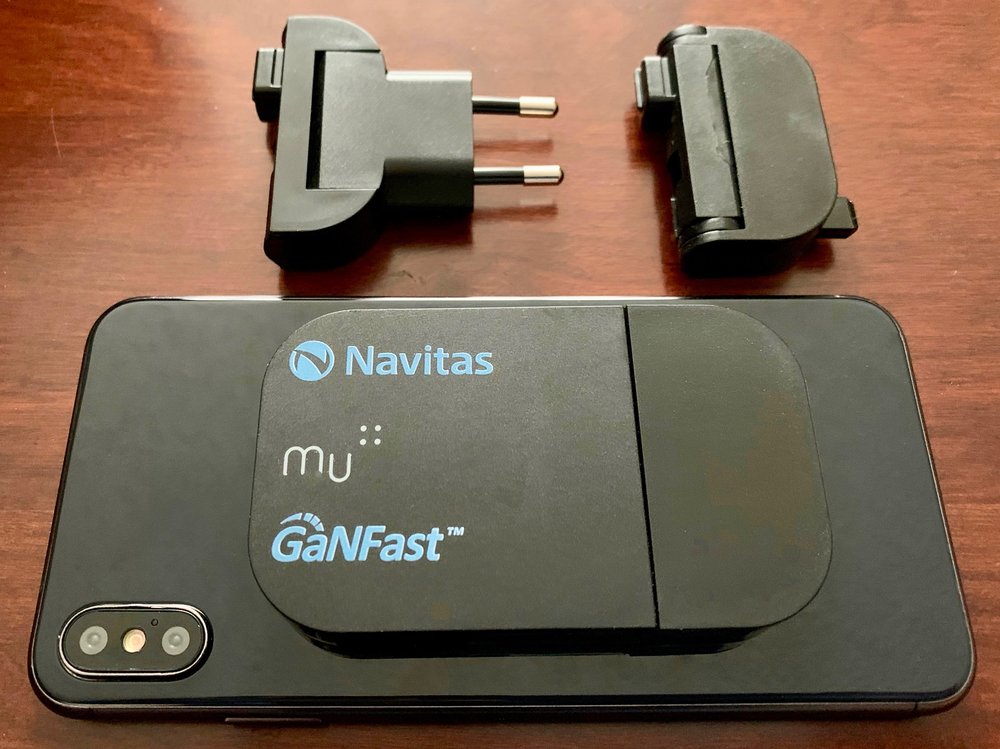There are times I really love my job as a technology writer, and this week has been one of those times. What’s the reason for my enthusiasm? Getting to put my hands on new charging technology that is going to revolutionize consumer electronics. Yesterday I reviewed the Elecjet Apollo Traveller Power Bank, which uses graphene technology to make a safe, cool-running and fast charging battery pack, and today I’m going to tell you about what’s known as GaNFast ™, which uses a Gallium Nitride based power chip rather than traditional silicon.

I had a chance to test a state-of-the-art charger called the Mu One (US$69.99, Amazon Affiliate link), which uses this new power integrated circuit technology from Navitas to create a lightweight 45W charger that is only 14mm (0.55 inches) thick and weighs just 82 grams (2.9 ounces). The Mu One comes with interchangeable plug heads for US, UK and European outlets that take just a few seconds to swap out, so this is perfect for those who are traveling overseas. By the way, UK plugs are usually horrendously huge; Made In Mind (the design house behind the Mu One) developed an ingenious swiveling UK plug that is 70% smaller than usual.
So what’s all this about Gallium Nitride? It’s a transparent material that is just now beginning to be used in power supplies and it will probably supplant plain old silicon power chips in quick order. Why? Well, all materials have what’s called a “band gap” that relates to that material’s ability to conduct electricity. Gallium Nitride has a much wider band gap than silicon, meaning that it can handle higher voltages and also conduct electricity faster.
For the layman (and I count myself in those ranks), this means that GaNFast chargers are smaller and less apt to heat up during charging as they are much more efficient. Martin Kuball, a physicist at the University of Bristol who was interviewed by The Verge in a recent article about Gallium Nitride , says that replacing all current electronics with GaN could cut energy usage by 10 to 25%.

In my testing of the Mu One, I wanted to be able to see just how fast this charger is. I was impressed with the thin profile of the charger, which fits flat against the wall (the plug prongs fold out, except on the UK plug head). As I no longer own a USB-C-based MacBook Pro, I used my 2018 iPad Pro as a test subject. Charging from 80% to 100% took about 55 minutes. That’s no faster than what I’m used to with the usual Apple USB-C charger, which is only an 18W device, and I’m not really sure why the iPad Pro — which is supposed to support USB-C Power Delivery — didn’t benefit from the Mu One charger. Where the Mu One really stood out is in charging the 5,000 mAh Apollo Traveler graphene battery pack, which it did in about 20 minutes. I’d be one happy camper if the Mu One let me charge that 9,720 mAh battery in the 12.9-inch iPad Pro in less than an hour…
The Mu One is a PD (USB-C Power Delivery) charger, so it detects the requirements of the device it is charging and then provides power at the fastest possible rate. PD chargers can be used with almost any USB device, so it’s possible to use one charger for a variety of devices. That’s one of the true benefits of this charger, since travelers can carry fewer different chargers with them.
As it is, I am impressed with the small size and low heat (high efficiency) of this first-generation GaNFast charger. As more USB-C PD devices become available, chargers like the Mu One will be all we’ll need to keep them charged up.
